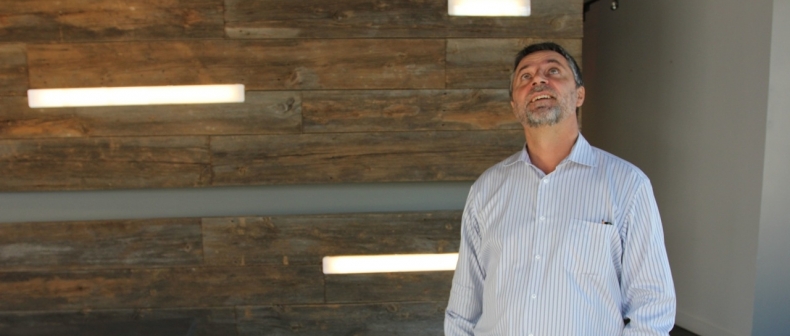
Demolition is scheduled to begin Monday for a midrise on Dundas in Little Portugal. It looks like it’ll be an attractive building, seven storeys swinging out individually over Dundas Street just west of Ossington, its bricks ensuring the confident design doesn’t alienate the surrounding Vicwardians too much. It’s a good embodiment of the city’s Avenues and Mid-Rise Buildings guidelines, but it’s the man behind it who’s really worth reading about.
I’ve spoken with a lot of developers over the past decade or so as our city entered its post-pubescence, growing out of its sprawling baby fat into its increasingly tall and slender form. The group of mostly men (and one notable woman) bring their various qualities to the market-driven shape Toronto’s being whipped into, and though those qualities do not tend to be architectural, they have been impressive in one way or another, sometimes personally, sometimes just by dint of the scale of their ambition and the stamp they’ve put on the city.
But they’re mostly what you’d expect: rich men from real estate families who build because that’s what they do, enriched clear out of their parents’ and grandparents’ neighbourhoods and tax brackets because of this extraordinary wave of urbanization they’ve been able to surf. Some of these men have built dozens of towers, and are on the books for dozens more. The Toronto we have, and that our children and grandchildren will have, is being built by them.
Though one could argue that cities would not grow as fast or as well without its moguls, Antonio Azevedo is different in a way that makes me hope he’s the beginning of a trend, a second or third wave of Toronto developers. If this does become a trend — and Les Mallins of Streetcar may be another example — we could call them citizen developers. Richer than me, but not as rich as Leo Delzotto. People who will start building in more easily comprehensible ways, and with motivations that go beyond the deal-making and the money-raking. People who get into it to build buildings, not fortunes.
Azevedo’s the son, grandson and great grandson of masons, an Azorean line that he says goes back 200 years. He broke the line when he went to law school in the 1980s, but his parents supported him, co-signing the mortgage when he decided to buy a house in Parkdale and renovate it while still an articling student in 1987. “They were pretty stressed out about that,” he says, smiling now, knowing exactly what it took for a family with a stone mason’s income to take on that kind of debt for their wannabe hotshot son, as well as how it turned out.
He renovated it and sold it in 1989, weeks before the bottom fell out of the market in the worst real estate plunge the city’s had, in that century or this. He made a profit, and though it was exactly a decade before he’d invest again, he’d seen the way for him to carry on the family business.
Above: Azevedos inside the Abacus showroom. Below: Artist’s rendering of Abacus on Dundas St. WHe became a personal injury lawyer, set up his own practice, and in 1997, bought the College Street building his firm, Azevedo and Nelson, still operates out of. He partnered with a friend, and then a colleague on two other projects, but it was three unlikely looking houses on Vine Avenue, an unlikely street in an unlikely neighbourhood that got him hooked and helped his thoughts on development to start coalescing.
Azevedo figured if he was going to sell anything on Vine, it would have to be to people who didn’t mind the severely urban setting: across from train tracks that separated the Junction from an industrial park.
After paying about $800,000 for two non-descript semi-detached homes and one old fire-damaged Victorian number that was slouching into itself, he hired an Azorean architect who dealt in contemporary design and took it to the required public neighbourhood meeting.
“Lots of Victorians on that street,” he says. “Everyone shows up and says ‘We don’t want modern, we want Victorian.’ It’s almost like they want architectural homogeneity. Me being of Azorean background — not exactly old English or Scottish — my family hasn’t been here for a hundred years. I’m not part of this homogenous group: I don’t think it exists anyways. It’s almost as if architecturally, people have trouble seeing beyond what exists. And culturally, I don’t think that’s healthy. I think a good diversity in people, in design, in style, I think it makes for a much healthier environment.”
He got his approvals, built his townhouses and sold them all in 2011, once again at a profit. Which brought him to his current project, Abacus, on Dundas at Ossington, he’s building on the site of an old and mostly disused garage he bought in 2010 for $1.9 million.
He did a few things that other, more regular developers tend not to. He didn’t sell to investors, for one, actually refusing people who wanted to buy more than one unit. “I didn’t want a bunch of absentee landlords,” he says, sitting in the mostly disassembled showroom he turned the garage into before the diggers came. “Hopefully I’ll do this again, I’ll take the same strategy. It reduces your backside risk. If the market drops, investors will drop like that. You want someone who’s emotionally invested.” After the first weekend, and the legally mandated 10-day cooling off period, he had sold 60 per cent of the building.
He also financed it on his own, qualifying for a mortgage that could take care of the $1.9 million sale price, as well as soft costs — like hiring architect Richard Witt to do the design and the drawings he figures did much of the selling for him — that he says exceeds it.
And unlike most bigger developers whose roots are suburban, Azevedo grew up downtown. Within a few hundred metres of Abacus, as it happens, and it’s this history, this connection, that’s driving the fundamentals of this building. He wants to get the neighbourhood back to the way it was, helping Dundas become the sort of strip he remembers the College Street of his childhood being.
“When my parents moved onto Montrose in 1970, I think, they were all immigrants,” he says, “and from what I understand it goes back a fair way. You had vibrant commercial strips. Why? Because there were three, sometimes four families to a house. Cars were expensive, so everyone did their shopping on College Street. My mother would go to College Street to buy clothes, or the Kensington market. These days, you’ve got box stores, you get in a car, you can leave your neighbourhood to do a lot of shopping, so that puts more pressure on the vibrancy of the commercial strip. So you really need to increase the density. The immigrants are going or gone, and the immigrants who stayed are no longer several families to a house, they’re an old couple alone in a house. That’s really decreased the density over all these years. It would be crap if you started building towers in the middle of the single-family neighbourhoods, or even mid-rises, but the avenues offer the perfect opportunity to increase densities by virtue of these mid-rise buildings.”
Though he tells me he doesn’t know much about urban planning, I can think of no better vision for the city than that. And I can think of no better sort of a person to realize it than people who think of cities as positive goods rather than necessary evils, who build where they live and live where they build, citizen developers. Let’s hope more of them come along soon.
____
Bert Archer writes for Toronto Standard. Follow him on Twitter: @bertarcher.
For more, follow us on Twitter: @TorontoStandard, or subscribe to our newsletter.














